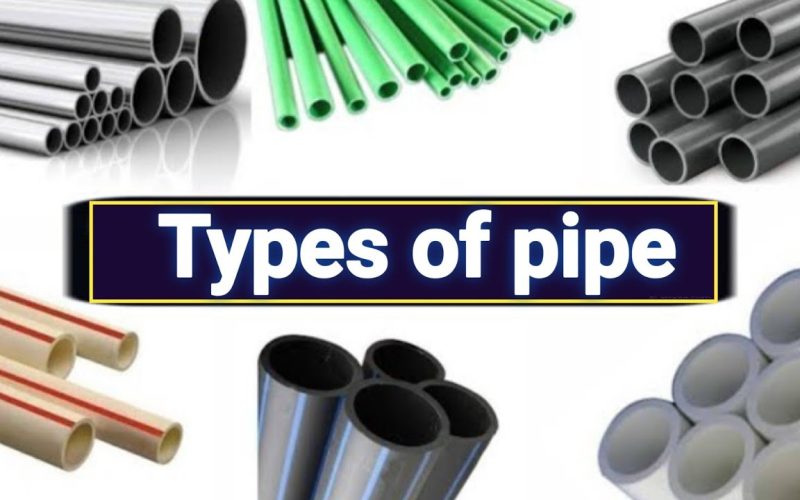In every plumbing work, there must be a pipe/pipes. However, pipes are valuable for plumbing work; people use them in engineering and water supply.
A pipe is a hollow cylinder with a valuable circular cross-section for transporting fluids. Ceramic, glass, fiberglass, numerous metals, concrete, and plastic are only a few materials manufacturers use to make pipes.
However, people choose pipes based on their functions. This article discusses different types of pipes used on several occasions. Read on!
1. Cast Iron Pipe
Pig iron is the main material manufacturers use in making cast-iron pipes. This pipe is famous for its city water distribution system because of its lifespan and excellent corrosion resistance.
It proved to be a useful material for producing water pipes, and it is a substitute for the original elm pipelines used previously.
Among the different types of pipes, the cast iron pipe is available in various wall thickness classes for pressures ranging from 0 to 350 psi. Furthermore, it has the potential to last for 100 years.
2. Brass Pipe
Brass pipes are a common type of pipe made of copper and zinc alloy. People use them for household objects such as doorknobs, locks, and bearings.
Though they are plumbing pipes, they are rare due to their high cost. It is compact, has superior thermal conductivity, and has high low-temperature strength.
A brass pipe has identical advantages and disadvantages to copper tubing, except that we can use a brass pipe in a drain pipe under pressure and screw the junctions between brass pipes.
3. Acrylonitrile Butadiene Styrene Pipe
This pipe is another type among the different types of pipes. Manufacturers make the ABS pipe by polymerizing acrylonitrile and styrene in the presence of polybutadiene.
This kind of pipe drains wastewater and sewage from homes. ABS has better mechanical properties than other common polymers, like impact resistance, toughness, and rigidity.
While it is for pipes, it is also used for computer keyboards and wall socket faceguards. It is also resistant to corrosive substances and has a low melting point.
4. PVC Pipe
PVC, which stands for polyvinyl chloride, is among the different types of pipes. It is one of the most popular pipe materials.
German chemist Eugen Baumann developed PVC in 1872. The polymer was visible as a white solid inside a flask of vinyl chloride stored on a shelf away from sunlight for four weeks. PVC is into two types: rigid and flexible.
Adding plasticizers can make it more flexible. PVC is also used in pipe construction and profile applications like windows and doors.
5. Galvanized Steel Pipe
The term “galvanized pipe” refers to steel pipes that have been coated with zinc to protect them from corrosion and rust.
This style of pipe was common in homes built before 1960. Galvanized steel nuts, bolts, and nails are corrosion-resistant and long-lasting.
The difficulty with galvanized steel pipes is that the zinc coating eventually erodes, forming rust.
6. Copper Pipe
Among the different types of pipes, this pipe is a small-diameter copper tube-like material for plumbing.
Copper is a relatively soft metal, and as a result, we can bend copper pipes easily.
The three most common types of copper pipes in residential and commercial construction are Type K, Type L, and Type M. Type K is the most common type of copper pipe people use in residential and commercial construction.
The fourth type of piping is useful for drain-waste-vent (DWV) piping.
7. Asbestos Cement Pipe
Asbestos cement pipe is a tubular cement liquid transfer vessel from asbestos.
It was popular in potable water distribution systems in the mid-nineteenth century, particularly in the western United States.
The asbestos pipe comprises silica, asbestos, and cement, forming a compact, homogeneous material with high strength.
Although asbestos is highly resistant to corrosion, it degrades over time, replacing current asbestos pipe systems more frequently.
8. Stoneware Pipe
Stoneware pipes are among the different types of pipes. They are drainage pipes from ceramic materials, typically four or six inches in diameter.
They produce them in ceramic industries by burning soft soil at high temperatures, which results in a brittle product. Pottery or other ceramics burnt in reasonably high temperatures are stonewares, a rather broad phrase.
Furthermore, they are relatively inexpensive to manufacture and simple to install but prone to cracking.
9. Galvanized Iron Pipe
People use galvanized iron pipes to distribute gas, water, or other liquids throughout a building’s infrastructure.
They comprise mild steel sheets and can be manufactured in 12 mm to 150 mm diameters. They are also available in lengths ranging from 6 meters to 12 meters.
We can easily connect them, and threading, cutting, and bending are all simple tasks. A socket is useful for connecting the two pieces.
These pipes are lightweight and inexpensive. They are negatively impacted by acidic and alkaline waters.
10. Concrete Pipe
Concrete pipe is the last on our list of the different types of pipes. They are hard pipes that serve as both structural support and a conduit.
These pipes are solely constructed of concrete. People use concrete pipes with enormous diameters to discharge huge amounts of drainage water.
Smaller diameter pipes are more useful for tiny flows because they are more efficient. The primary characteristics of concrete pipes apply to sanitary sewers, storm sewers, and culverts.









It’s nice that you pointed out how cast iron pipes have the potential to last for 100 years. Our resident plumber checked our plumbing system the other day and it seems some parts of it are already broken. It wouldn’t do to just leave it be so I’ll try to grab some plumbing supplies later and ask the plumber to fix the damaged parts of the system.